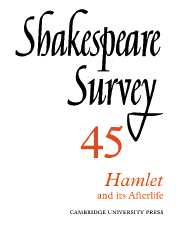Book contents
- Frontmatter
- The Reception of Hamlet
- ‘Hamlet, Revenge!’: The Uses and Abuses of Historical Criticism
- Revision by Excision: Rewriting Gertrude
- Gazing at Hamlet, or the Danish Cabaret
- ‘He’s Going to his Mother’s Closet’: Hamlet and Gertrude on Screen
- Shakespeare Rewound
- Freud’s Hamlet
- ‘Pray you, undo this button’: Implications of ‘Un-’ in King Lear
- Marx and Shakespeare
- Peter Street, 1553–1609: Builder of Playhouses
- Shakespeare Performances in England 1990–1
- Professional Shakespeare Productions in the British Isles, January–December 1990
- 1 Critical Studies
- 2 Shakespeare’s Life, Times, and Stage
- 3 Editions and Textual Studies
- Books Received
- Index
Gazing at Hamlet, or the Danish Cabaret
Published online by Cambridge University Press: 28 March 2007
- Frontmatter
- The Reception of Hamlet
- ‘Hamlet, Revenge!’: The Uses and Abuses of Historical Criticism
- Revision by Excision: Rewriting Gertrude
- Gazing at Hamlet, or the Danish Cabaret
- ‘He’s Going to his Mother’s Closet’: Hamlet and Gertrude on Screen
- Shakespeare Rewound
- Freud’s Hamlet
- ‘Pray you, undo this button’: Implications of ‘Un-’ in King Lear
- Marx and Shakespeare
- Peter Street, 1553–1609: Builder of Playhouses
- Shakespeare Performances in England 1990–1
- Professional Shakespeare Productions in the British Isles, January–December 1990
- 1 Critical Studies
- 2 Shakespeare’s Life, Times, and Stage
- 3 Editions and Textual Studies
- Books Received
- Index
Summary
“A was a man. Take him for all in all, / I shall not look upon his like again” (1.2.186–7). Among all the doubts, fears, uncertainties attendant on his father’s death, there’s this for Hamlet to contend with too, this hinted anxiety about keeping up the old gender-roles. Where once men were men, and women - hanging upon them as if increase of appetite did grow where it did feed – women, there now rules an ambiguous queen-king: bidding Claudius farewell for England, Hamlet calls him ‘dear mother’, because ‘Father and mother is man and wife, man and wife is one flesh, and so my mother’ (4.3.51–4). And Hamlet himself? In this essay I want to look at some moments in Hamlet’s cultural history when the Prince’s own sex or gender (the slippage between those terms is part of that history) have been defined in unusual ways. Apart from their occasional bizarrerie, they interest me because they suggest that Hamlet, that great drama of patriarchal piety and misogynistic rage, has had under certain circumstances the power to shake the most firmly-planted binary representations.
Or perhaps those representations were ripe for shaking from the start? Several recent critics, including Thomas Laqueur and Stephen Greenblatt, have drawn attention to a possibility latent, at least, within Renaissance ideas about sexual anatomy. Ian Maclean concisely reports the basic case:
In Aristotelian and Galenic terms, woman is less fully developed than man. Because of lack of heat in generation, her sexual organs have remained internal, she is incomplete, colder and moister in dominant humours, and unable to 'concoct' perfect semen from blood. Two axioms are implied here: that the hottest created thing is the most perfect, and that a direct comparison can be made between the genitalia of man and woman in function, number and form.
- Type
- Chapter
- Information
- Shakespeare Survey , pp. 37 - 52Publisher: Cambridge University PressPrint publication year: 1992



